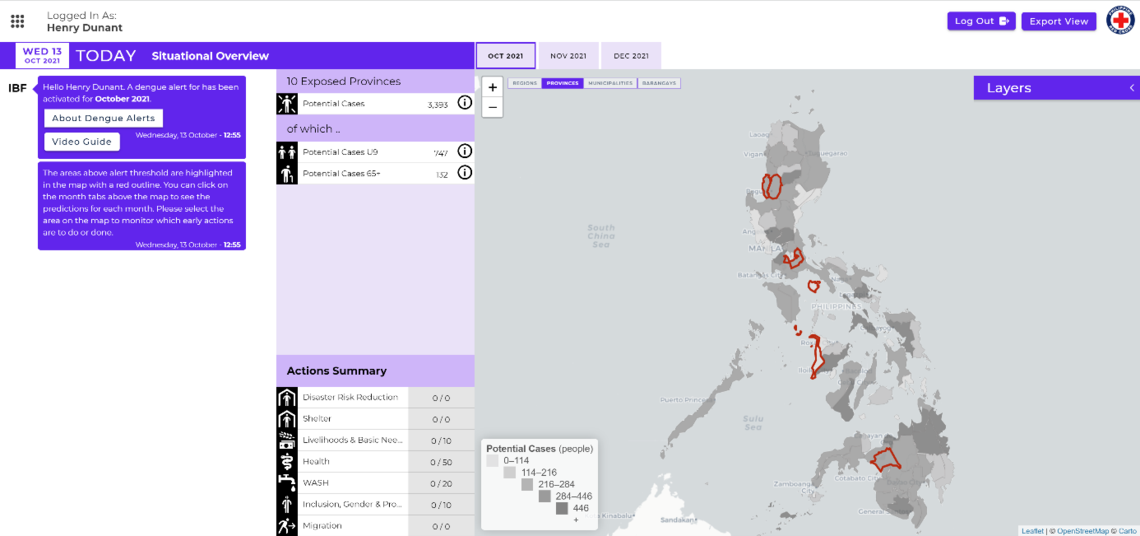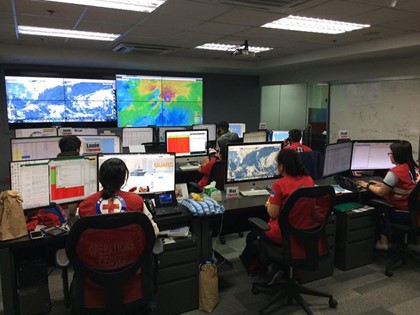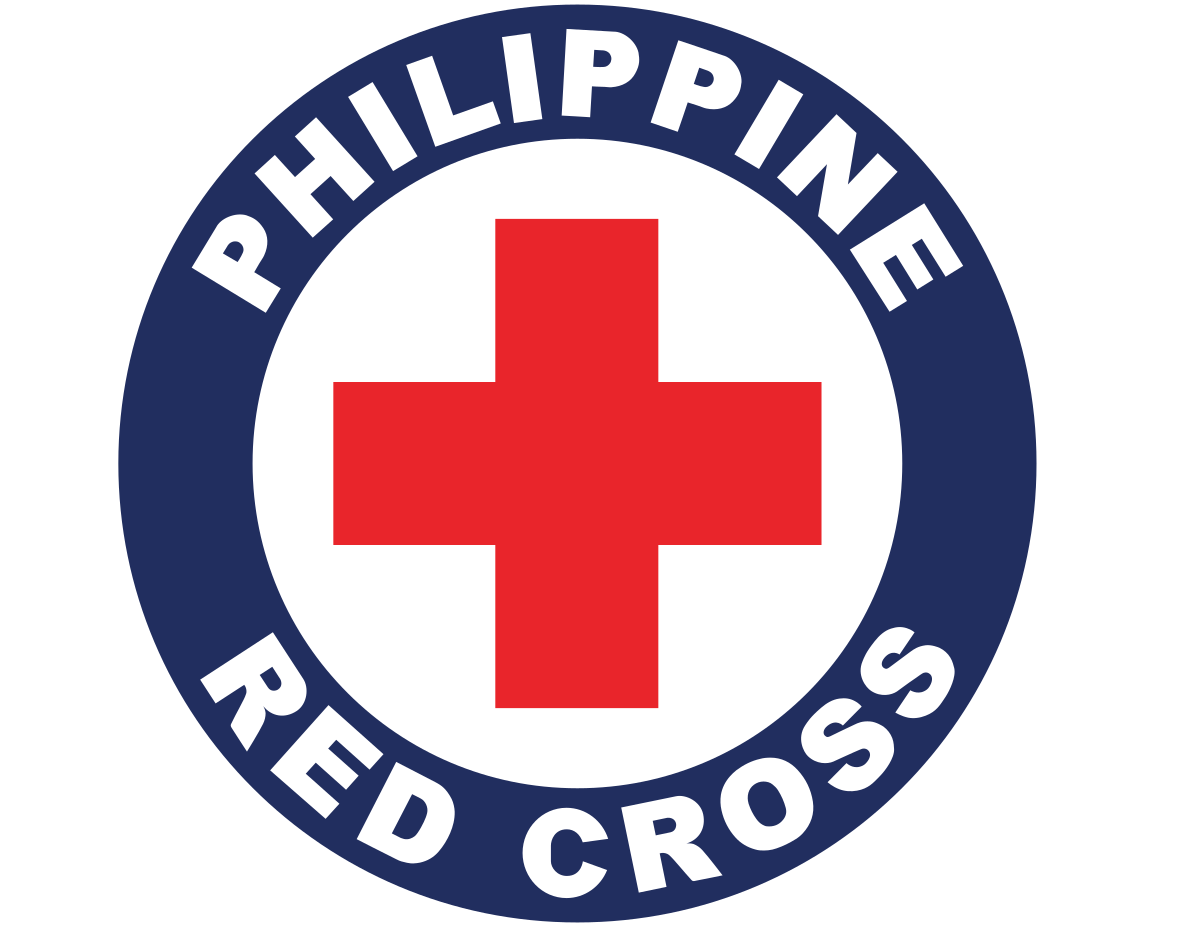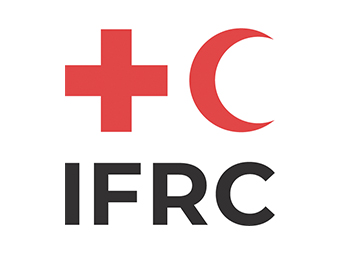IBF Dengue portal: from emergency response to early detection and prevention
In the last 50 years dengue fever has spread from nine to over a hundred countries, making it the fastest spreading vector-borne disease. This type of disease is spread by blood-feeding anthropods like mosquitoes. The number of cases have increased from 15,000 per year in the 1960s to 390 million today. Over 40 percent of the world's population is at risk from dengue. The overall burden of the disease varies from region to region, with Asia-Pacific hosting 75 percent of those at risk. This includes The Philippines, where dengue poses a major issue.
510 developed the Impact Based Forecasting (IBF) Dengue Portal in order to predict which areas are prone to dengue outbreaks and thus to mitigate their impact. The IBF Dengue Portal was launched on the 1st of July. Read the case study here.
IBF Dengue Portal
Dengue viruses are spread to people through the bite of an infected mosquito. Environmental conditions that are hot and humid are favorable for mosquitoes to reproduce. Weather data, such as temperature and rainfall, is used as input for the IBF Dengue Portal to predict these conditions. The IBF Portal gives a prediction of each month for each individual province in The Philippines.
‘The portal is a convenient way to report and gives suggested action. Hospital locations are included in the portal so the PRC can send ambulances to the right locations’, says Ghazal Ayobi, Data Analyst at the Philippine Red Cross.
The portal releases an alert up to 2 months ahead when the risk of dengue outbreak in a specific province and correspondingly the expected number of dengue cases satisfy the alert conditions. ‘Unlike floods and typhoons, Dengue is always present in The Philippines. What we try to do is predict if the number of cases is so high that it forms a problem for the local healthcare system’ says Jacopo Margutti, Data scientist at 510. The alert threshold is reached when the amount of expected cases is higher than usual. The epidemic threshold is reached when the number of cases is extremely high. ‘If we take early actions, we can also reduce the impact of these outbreaks’ Margutti adds.

Early actions
The portal allows proactive response that mitigates the impacts brought by infectious disease. ‘The early action plan prepares the organization to allocate the it’s recourses to their respective places’, says Ayobi. Early actions are developed collaboratively with all organizations involved to decide on what anticipatory actions to undertake. The early actions can be divided into three areas of focus: 1. Health, 2. Water Sanitation and Hygiene (WASH), and 3. Protection, Gender and Inclusion (PGI) Examples of Health include: setting up Dengue Emergency Medical Units (DEMU’s), mobilizing Community Health Volunteers (CHV), social media campaigns promoting prevention and control measures. WASH examples include: hygiene promotion on safe usage of water and cleaning of mosquito breeding sites, and garbage disposal. Examples of PGI include ensuring all staff received PGI training, and to distribute PGI guidelines.

Balancing Human Centered and Strategic Product Design
The IBF Dengue Portal was co-designed with Aid Workers from The Philippines Red Cross Using Human Centered Design (HCD) methods. Ayobi elaborates by saying that ‘each country has their own background and culture and therefore different needs. Co-design is really important to consider those needs.’
When building a product it is important to center it around the user, this can be difficult to achieve when you work on a project base. The trick is to find the balance between the project with needs of local end users facing specific disasters with the projects addressing other global end users with different cultures facing many disaster types. Orla Canavan (Strategic Product Designer (SPD) lead at 510) and the design team addresses this line by combining HCD methods with SPD methods to ensure there is efficient product design scoping.
How? Canavan elaborates by saying: “Combining HCD and SPD methods allows us to both learn from the local expertise where they champion their needs whilst informing how to create the best modular design. When we were asked to co design for Dengue with Philippines RC we already had a “IBF Portal block design” that was informed by a data base of general insights into cognitive decision making before disasters informed by multiple co design sessions across many national societies and many disaster types including floods, drought, heavy rain and Typhoons & Damage Assessment. HCD allows us to co design without bias with the Philippines team, then through clustering identify which Dengue specific needs should be added to the general block design and test it”.
Based on the Dengue co design results, the design team quickly created a prototype and tested it with the end users and this together with great ideas from the developer Ruben van der Valk, meant not only was the IBF Dengue Portal set up for success efficiently, but any incremental functionality could also be added back into to the other “IBF Portal block designs” where possible.
Organizations involved
The Philippines Red Cross (PRC) decides on execution of early actions in coordination with NDRRMC and DoH, implements early actions. The Netherlands Red Cross (NLRC) data team 510 provided technical support in developing the IBF portal and drafting this document. The NLRC provided the financial support towards the IBF portal development and coordinated the technical support from various partners towards PRC. The National Disaster Risk Reduction and Management Council (NDR-RMC) leads the coordination of the dengue emergency response. The Department of Health (DoH) declares dengue alerts and emergencies, oversees prevention campaigns, and manages the health system. The German Red Cross (GRC) is currently exploring the development of an Early Action Protocol (EAP) for dengue. The Princess Margriet Fund financially supported the development of the tool.
510’s role
The PRC and 510 worked closely together to develop a model that predicts Dengue outbreaks in The Philippines. In addition, the IBF Dengue Portal was developed to give a clear and structured overview of the information. ‘Human Centered Design was used in the development of the software in order for the data to be translated into something useful and useable by The Philippines Red Cross’ Margutti adds.
Next steps
One of the most important future actions is getting the Early Action Protocol (EAP) approved. The EAP is developed collaboratively with all organizations involved to decide on what anticipatory actions to undertake. In addition, Ayobi adds: ‘We are also planning to give better insight in hospital beds. Right now this is the case for covid but not yet for Dengue. Having this number will enable us to give an estimation of how many people a hospital in each region can still take in.’
The IBF Dengue Portal is currently also being developed for Ethiopia where it will be deployed to mitigate the impact of Malaria outbreaks.
If your National Society needs help with the setup of a similar tool please contact Stefania Giodini (sgiodini@redcross.nl) or Jacopo Margutti (jmargutti@redcross.nl).



